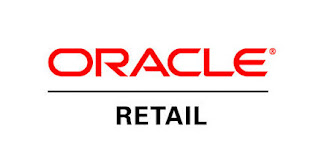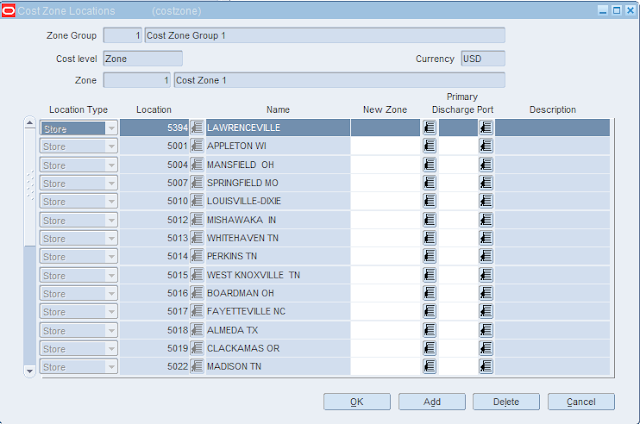- Cost Zone Groups may contain one or more Cost Zones while Cost Zones may contain one or more locations.
- A Location may belong to Cost Zones in different Cost Zone Groups, but within a given Cost Zone group, a location can only exist once.
- A location may only belong to a single Cost Zone within any given Cost Zone Group.
- All locations (including warehouses) must belong to a Cost Zone Group.
- Within a Cost Zone Group, locations can move from one zone to another.
- When you enter a new Cost Zone Group, all locations must be added to the group.
- When a new location is added to RMS, the location is assigned to existing Cost Zone Groups and Cost Zones based on the zoning location selected during the setup of the store or warehouse.
Field
|
Required
|
Functionality
|
Cost Zone Group ID
|
Y
|
Contains the identification number of the zone group in which the zone is located.
|
Cost Level
|
Y
|
Contains the pricing level of the zone group. Valid values are:
‘L’ = Location
‘Z’ = Zone
‘C’ = Corporate
There will be one record with a Location cost level, but there can be an infinite number of records with a Zone cost level.
|
Cost Zone Group Description
|
Y
|
Contains the description of the cost zone group.
|
Like Group
|
N
|
This can be used to copy from an existing Cost Zone Group.
|
Field
|
Required
|
Functionality
|
Cost Zone ID
|
Y
|
Contains the zone identification number which uniquely identifies the zone. If the cost level of the zone group is store, then the zone will be the store number.
|
Cost Zone Description
|
Y
|
Contains the name of the zone. If the cost level of the zone group is Store, then this column contains the store name.
|
Currency
|
Y
|
This field contains the currency code for the zone. Each zone will have a currency code attached to ensure that each store location associated with the zone shares the same currency.
|
Base Cost Indicator
|
Y
|
Indicates whether or not this zone will be used as the default for the base cost zone. Valid values are ‘Y’ and ‘N’.
|
Field
|
Required
|
Functionality
|
Location Type
|
Y
|
This field indicated whether the value in the LOCATION field is a store value or a warehouse value. Valid values for this field are:
S – Store
W – Warehouse
|
Location ID
|
Y
|
Contains the store or warehouse number which uniquely identifies the location.
Whether this field contains a store or warehouse is determined by the LOC_TYPE field. If the cost level of the zone group is Location, then the location value will be equal to the zone value. There must be exactly one record for every store and warehouse in every zone group.
|
New Zone ID
|
Y
|
Contains the zone identification number of the zone within the zone group. If the cost level of the zone group is Location, then the location value will be equal to the zone value.
|
Primary Discharge Port
|
N
|
Allows the user to select a Primary Discharge Port for the location. This is used for defaulting in the Expense functionality.
|
About Nagesh Mishra
Nagesh Mishra - A Passionate Oracle Retail Certified Professional with more than 17 years of overall experience in IT industry and more than 15 years of domain expertise in Oracle Retail Applications. Worked extensively in diversified fields of Product Implementation, Business Consulting, Pre-Sales, Application Software Development, Maintenance and Support and Re-Engineering Oracle Retail projects.





0 comments :
Post a Comment